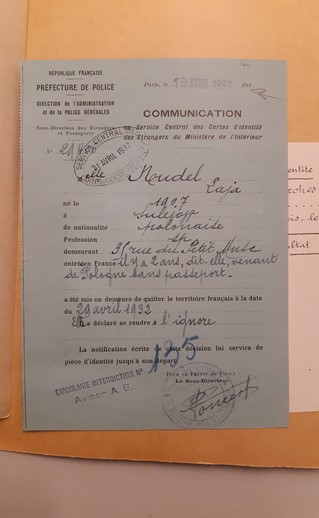Laja NUDEL, épouse SZWALBERG
————————————————————————————————
Für unsere deutschsprachigen Leser*innen: Die Biographie ist unterhalb der französischen Version auch auf Deutsch verfügbar.
————————————————————————————————
Since there are no photographs available of Laja Nudel, the image to the left is a copy of her foreign national’s identity card.
Laja Nudel’s parents were Bernard and Matla (or Makla) Nudel. She was born in Sulejow (also known as Silar) in Poland, in 1902 or 1907. Her year of birth varies according to the official records.
Laja spent her childhood in Poland and appears to have left her native country for France in the late 1920s. In April 1932, Laja was living at 35, rue du Petit Musc in the 4th district of Paris, as shown in the document below, from the Ministry of the Interior’s department for foreigners’ identity cards. She then “resided in the provinces” as mentioned in the following extract from a Police Headquarters record dated April 1951.

It was in France, in the early 1930s, that she met her future husband and the father of her children, Joseph Szwalberg. He appears to have arrived in France in January 1922. When he obtained his identity card and travel permit from the Police Headquarters in Paris on May 26, 1930, Joseph Szwalberg was living at 257 Avenue des Acacias in the 17th district of Paris. He was listed as a leather worker by profession. Laja appears to have married Joseph in about 1933, probably in the city or suburbs of Paris.
The couple had five children: Armand (also spelled Hermann), who was born in 1934, David born in 1935, Madeleine, born in 1936, Georges, born in 1938 and Michel, who was born in 1941.
To read more about the Szwalberg children, please see their biographies on this site.

David Szwalberg’s birth certificate. He was born on March 4, 1935 at the Saint-Antoine hospital in the 12th district of Paris – Source: Civil status registry for the 12th district of Paris
The couple initially appear to have lived at 1, rue de la Gare in Sevran, (which is now in the Seine-Saint-Denis department of France), as mentioned on David’s birth certificate dated March 1935. They then moved to Villepinte (also now in Seine-Saint-Denis) The Szwalbergs lived at 52, chemin de l’Arbre Sec, as can be seen on their daughter Madeleine’s birth certificate and on the extract from the 1936 census of Villepinte. It reveals that Laja was not working, as had been the case in 1932, and that her husband Joseph was a bricklayer, as he was when their son David was born in 1935.

1936 census of Villepinte – Source: Seine-Saint-Denis archives
The move again in February 1938, to 5 impasse des Amandiers, in the 20th district of Paris. Joseph appears to have been mobilized in 1939. Still a Polish citizen, Laja was still living at this address in 1941, together with her husband and children. By that time, Joseph was a deliveryman by profession, as stated on his identity card that was issued at the same time.
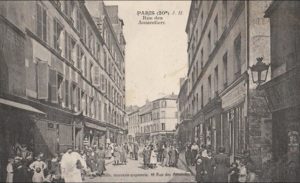
La rue des Amandiers in the 20th district of Paris, between the wars. Source: Geneanet
However, only a few months after Michel was born, the family’s life was turned upside down when Joseph was arrested on June 9, 1941. The arrest appears to have taken place at about 11 pm in a bar at 98 Boulevard de Belleville in the 20th district of Paris. Although he may have been released initially “on account of his military service and his family situation”, Joseph was subsequently interned in Drancy and perhaps in Compiègne. Sadly, he was eventually deported for political reasons, which is to say because he was Jewish, from Drancy to the Auschwitz concentration and extermination camp. The convoy left Drancy on March 27, 1942 and Joseph survived for less than a month. He was declared to have died from a kidney infection on April 23, 1942 at 8:40 a.m. in Auschwitz-Birkenau.

Laja Nudel’s missing persons’ certificate dated 1951 – Source: Ministry of Veterans’ Affairs and Victims of War
What happened to Laja after her husband was arrested remains unclear. She must have realized that her entire family was in danger of being deported at any moment. It seems that she contacted the Order of the Priests at Notre Dame de Sion in Paris to ask them to find a safe place for her young children.
The three eldest children, Armand, David and Madeleine, were placed in the Varennes orphanage in Saint Maur des Fossés, which is now in the Val de Marne department of France.
The two younger children, Georges and Michel, were placed in the care of Abbé Antoine Dumas. They remained hidden with the abbot in the Loire department of France for the duration of the war.
On July 24, 1944, Laja was apparently arrested and interned in Drancy camp. There she met up with three of her children, Madeleine, Armand and David, who had also been rounded up in the children’s home three days previously and then interned in Drancy.
Laja and her children left Drancy on July 31, 1944, on Convoy No. 77 to Auschwitz-Birkenau. Laja was assigned deportation number 25678.

Present-day photograph of the Auschwitz-Birkenau camp. Source: Wikipedia
Laja was probably deemed too weak or unfit to work and was murdered in Auschwitz on August 5, 1944, as was her daughter Madeleine, who was only 7 years old. The timing of their deaths suggests that they both died in the gas chambers as soon as they arrived at the camp.
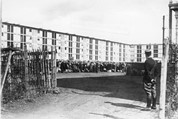
Photo of Drancy camp taken in August 1941
Laja Nudel, verheiratete Szwalberg
Laja Nudel, Tochter von Matla und Bernard Nudel, kommt in Sulejow, einer Stadt in Polen zur Welt. Ihr Geburtsjahr ist unklar, denn einige gefundene Dokumente geben als Geburtsjahr das Jahr 1902 an, andere sagen aus, sie sei 1907 geboren.
Sie verbringt ihre Kindheit in Polen und verlässt ihr Geburtsland, um Ende der zwanziger Jahre in Frankreich zu leben. Ein Dokument des Außenministeriums aus dem Jahr 1932 besagt, dass sie sich nach ihrer Ankunft in Frankreich im April 1932 in der Rue du Petit Musc im 4. Arrondissement in Paris niedergelassen hat, nachdem sie, wie in einem Polizeidokument festgehalten, in Frankreich eingewandert ist.
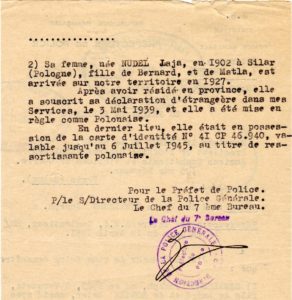
In Frankreich lernt sie anscheinend Anfang der 1930er Jahre ihren Ehemann und den Vater ihrer Kinder, Joseph Szwalberg, kennen. Dieser scheint im Januar 1922 in Frankreich angekommen zu sein. Als der Pariser Polizeipräfekt am 26. Mai 1930 seinen Personalausweis und Reiseausweis erhält, wohnt Joseph Szwalberg in der 257 avenue des Acacias im 17. Arrondissement von Paris. Er wird von Beruf Maroquinier. Laja heiratet Joseph 1933, wahrscheinlich in Paris oder einem Vorort.
Sie bekamen fünf Kinder: Armand (auch Hermann geschrieben), geboren 1934, David geboren 1935, Madeleine geboren 1936, Georges geboren 1938 und Michel geboren im Jahr 1941. Weitere Informationen zu den Kindern des Ehepaares Szwalberg finden Sie hier auch in einer Online-Biographie.
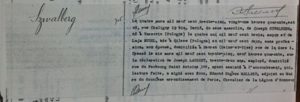
Geburtsurkunde von David Szwalberg, 4. März 1935 im Krankenhaus Saint-Antoine (12.Arrondissement von Paris.) – Quelle: Zivilstand des 12. Arrondissement von Paris
Das Ehepaar scheint sich zuerst in der Rue de la Gare 1 in Sevran (heute Seine-Saint-Denis) niedergelassen zu haben, wie auf Davids Geburtsurkunde im März 1935 angegeben wurde. Das Paar lebte dann in Villepinte (heute Seine-Saint-Denis). Die Eheleute Szwalberg wohnten dort in 52 Chemin de l’Arbre Sec, wie aus der Geburtsurkunde ihrer Tochter Madeleine und dem unten gezeigten Auszug aus der Volkszählung von 1936 der Stadt Villepinte hervorgeht. Außerdem zeigt der unter abgebildete Auszug , dass Laja wie 1932 auch 1935 immer noch arbeitslos war und dass ihr Mann Joseph Maurer war, wie bereits 1935, als sein Sohn David geboren wurde.
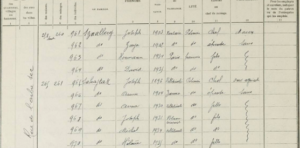
Volkszählung der Stadt Villepinte im Jahr 1936 – Quelle: Archiv in Seine-Saint-Denis
Einige Zeit später, im Februar 1938, zogen sie in die Impasse des Amandiers 5 im 20. Arrondissement von Paris. Joseph scheint 1939 mobilisiert worden zu sein. Laja, die immer noch polnische Staatsbürgerin war, lebte 1941 mit ihrem Mann und ihren Kindern weiterhin in derselben Adresse. Joseph war damals von Beruf Lieferbote. Dieses belegt sein am selben Tag ausgestellter Personalausweis.

Die „rue des Amandiers (Paris 20e) in der Zeit zwischen den Kriegen. Quelle: Geneanet
Nur wenige Monate nach Michels Geburt wurde der gewohnte Alltag der Familie durch die Verhaftung von Joseph am 9. Juni 1941 umgeworfen. Diese Verhaftung scheint gegen 23 Uhr in einem Getränkeausschank, auf dem Boulevard de Belleville 98 in Paris, stattgefunden zu haben. Er wurde vielleicht ein erstes Mal, „aufgrund seines Militärdienstes und seiner Familiensituation“ freigelassen und kam danach ins „Camp de Drancy“ und anschließend auch in das Camp in Compiègne.
Danach wird Joseph per Zug aus Drancy schließlich in das Konzentrations- und Vernichtungslager nach Auschwitz deportiert. Der Zug verlässt Drancy am 27. März 1942 und Joseph überlebt dort nur einen Monat. Sein Tod, aufgrund von einer Nierenentzündung, wurde am 23. April 1942 um 8:40 Uhr deklariert.
Lajas Schicksal nach der Verhaftung ihres Mannes bleibt bis heute noch sehr unklar. Da ihr klar war, dass ihre Familie jeden Moment ebenfalls deportiert werden könnte, scheint sie Kontakt mit dem Pariser Priesterorden Notre Dame de Sion aufgenommen zu haben, der ihr helfen sollte, ihre kleinen Kinder in Sicherheit zu bringen.
Die drei älteren Kinder Armand, David und Madeleine wurden in das Waisenhaus La Varennes in Saint-Maur-des-Fossés im heutigen Val de Marne gebracht.
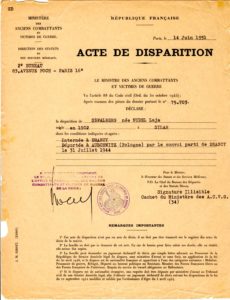
Der Akt des Verschwindens von Laja Nudel (1951) Quelle : Ministerium für ehemalige Kriegskämpfer– und gefallene
Die beiden jüngeren Kinder, Georges und Michel, wurden dem Abbé Antoine Dumas anvertraut. Sie wurden für den Rest des Krieges bei ihm im Departement Loire versteckt.
Am 24. Juli 1944 scheint Laja verhaftet und nach Drancy deportiert worden zu sein. Dort fand sie ihre drei Kinder Madeleine, Armand und David wieder. Diese wurden ebenfalls drei Tage zuvor aus ihrem Waisenhaus geholt und nach Drancy interniert.
Laja und ihre eingewiesenen Kinder verlassen Drancy am 31. Juli 1944 und nehmen am gleichen Tag den Convoi n°77 in Richtung Auschwitz-Birkenau. Daher trägt Laja die sogenannte Nummer der Deportation n° 25678.
Wahrscheinlich wurde sie für zu schwach oder arbeitsunfähig gehalten, sodass sie am 5. August 1944 in Auschwitz umgebracht wurde, genauso wie auch ihre siebenjährige Tochter Madeleine. Beide scheinen vergast worden zu sein.

Fotografie vom Camp in Drancy, August 1941.

Aktuelle Fotografie vom Camp in Auschwitz-Birkenau. Quelle : Wikipedia


 Français
Français Polski
Polski